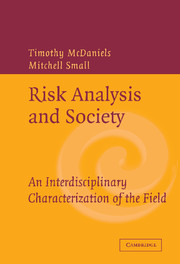Book contents
- Frontmatter
- Contents
- Contributors
- 1 Introduction – Risk Anaysis and Society: An Interdisciplinary Characterization of the Field
- PART ONE FUNDAMENTAL CHARACTER OF RISK
- 2 The Conception of Variability in Risk Analyses: Developments Since 1980
- 3 Mechanistic Considerations in the Harmonization of Dose-Response Methodology: The Role of Redundancy at Different Levels of Biological Organization
- 4 Risk of Extreme and Rare Events: Lessons from a Selection of Approaches
- 5 Environmental Risk and Justice
- PART TWO METHODS FOR RISK ASSESSMENT
- PART THREE NEW APPROACHES AND NEEDS FOR RISK MANAGEMENT
- SUMMARY AND FUTURE DIRECTIONS
- Index
- References
3 - Mechanistic Considerations in the Harmonization of Dose-Response Methodology: The Role of Redundancy at Different Levels of Biological Organization
Published online by Cambridge University Press: 05 June 2012
- Frontmatter
- Contents
- Contributors
- 1 Introduction – Risk Anaysis and Society: An Interdisciplinary Characterization of the Field
- PART ONE FUNDAMENTAL CHARACTER OF RISK
- 2 The Conception of Variability in Risk Analyses: Developments Since 1980
- 3 Mechanistic Considerations in the Harmonization of Dose-Response Methodology: The Role of Redundancy at Different Levels of Biological Organization
- 4 Risk of Extreme and Rare Events: Lessons from a Selection of Approaches
- 5 Environmental Risk and Justice
- PART TWO METHODS FOR RISK ASSESSMENT
- PART THREE NEW APPROACHES AND NEEDS FOR RISK MANAGEMENT
- SUMMARY AND FUTURE DIRECTIONS
- Index
- References
Summary
INTRODUCTION
There is a great deal of interest in developing more biologically insightful approaches to dose-response analysis, and also in achieving harmonization of the rationale and methods for analysis of cancer and noncancer endpoints (Beck et al., 1993; Conolly, 1995; Barton, Andersen, and Clewell, 1998; Conolly, Beck, and Goodman, 1999). These goals require one to think about how events at underlying levels of molecular and physiological activity are modulated by the action of a toxic agent, and how such low-level effects then propagate to produce the overt toxic effects seen in the living organism. In essence, we need to delve into how and why it is that varying levels of a toxicant lead to varying levels of response, dissecting the chains of cause-and-effect relationships involved. This paper explores some of these issues.
BASIC DOSE-RESPONSE APPROACHES
There are two broad approaches to analysis of dose-response relationships, and they correspond to two alternative rationales for why responses are observed to vary as a function of dose (Rees and Hattis, 1994). The first is the idea that a dose-response curve describes a tolerance distribution (Figure 3.1). Under this view, the population at risk consists of individuals who vary in the amount of an agent they can experience without ill effect (Krewski et al., 1999). In essence, each individual is assumed to have an exposure threshold, but the value of this threshold differs from one individual to the next (Eaton and Klaassen, 1996).
- Type
- Chapter
- Information
- Risk Analysis and SocietyAn Interdisciplinary Characterization of the Field, pp. 46 - 73Publisher: Cambridge University PressPrint publication year: 2003



